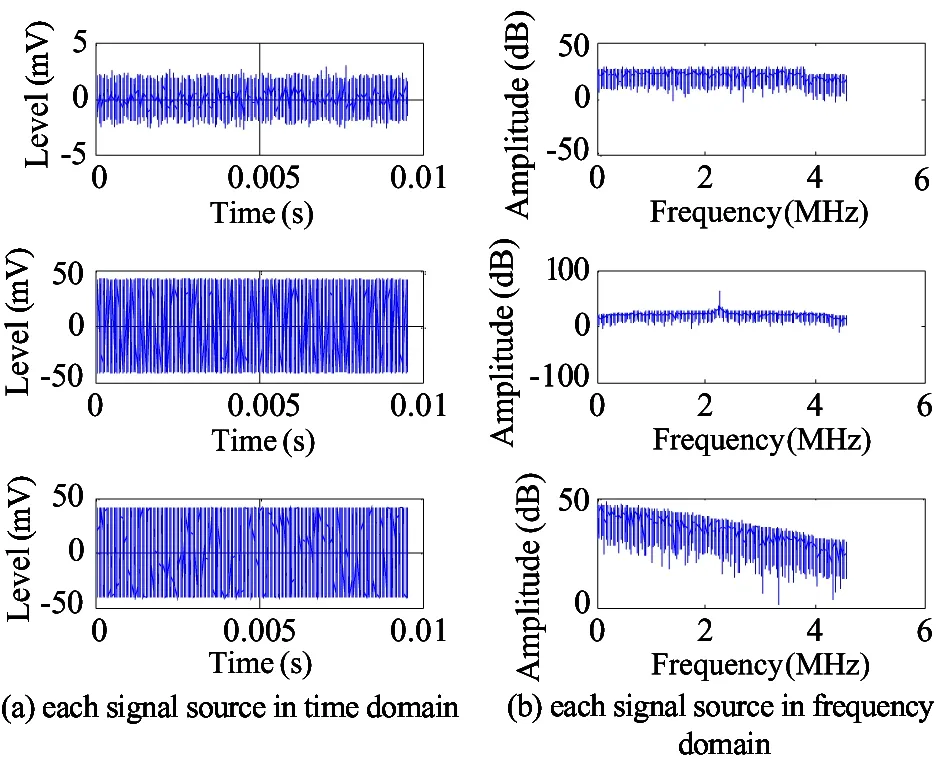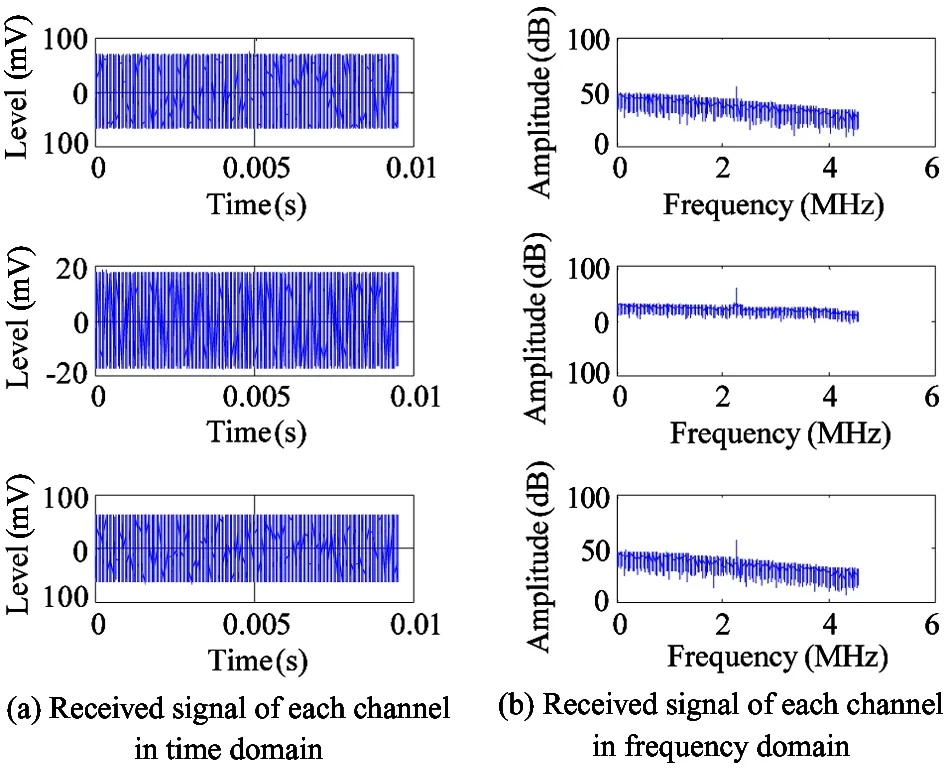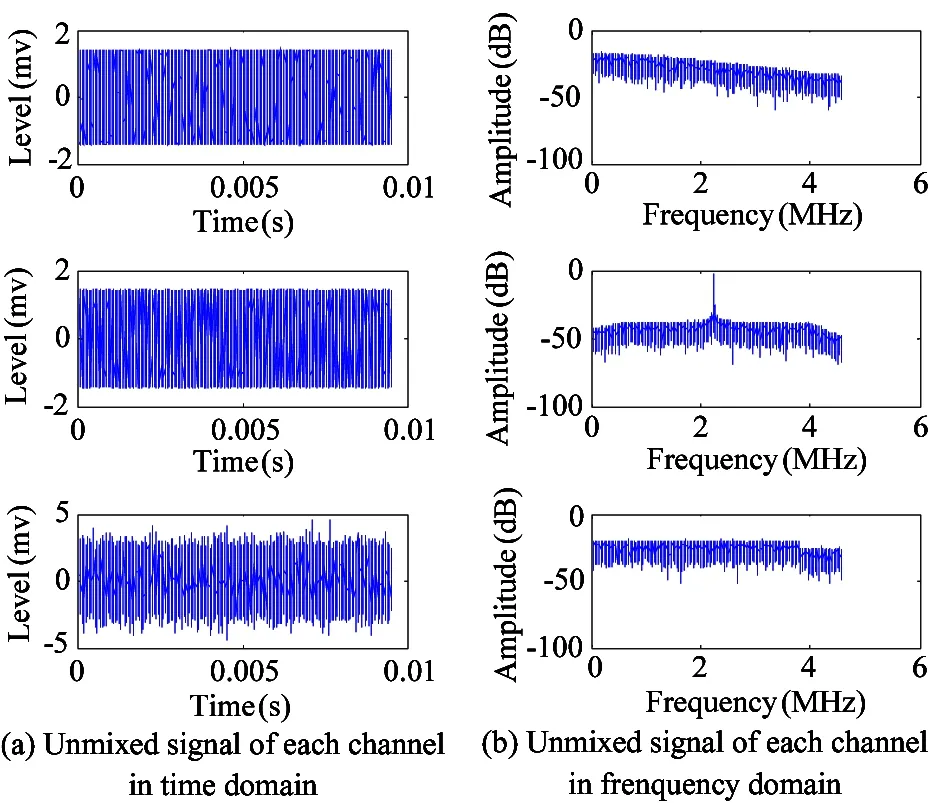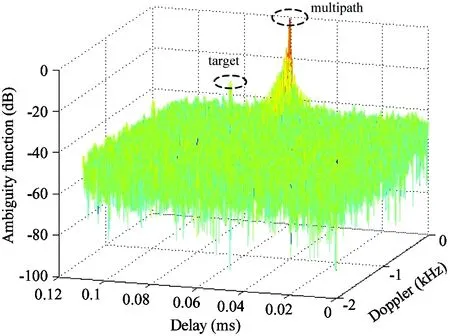Removal of jamming using independent component analysis in non-cooperative passive detection system①
Ying Tao (应 涛), Huang Gaoming, Shan Hongchang, Zuo Wei, Gao Jun
(College of Electronic Engineering, Naval University of Engineering, Wuhan 430033, P.R.China)
Removal of jamming using independent component analysis in non-cooperative passive detection system①
Ying Tao (应 涛)②, Huang Gaoming, Shan Hongchang, Zuo Wei, Gao Jun
(College of Electronic Engineering, Naval University of Engineering, Wuhan 430033, P.R.China)
Due to electronic jamming transmitted by hostile electronic jamming equipments and unintentional jamming from other illuminating sources in the complex electromagnetic environment, the performance of non-cooperative passive detection systems may degrade it significantly. To solve the problem, a receiving frame with multiple channels for signal preprocessing is designed and a theoretical analysis to the received signals in the complex electromagnetic environment is provided. Furthermore, a scheme for jamming removal using independent component analysis is proposed. Simulation results demonstrate the proposed scheme appears as a very appealing solution for removal of jamming and an approximate 10dB signal to distortion ratio over traditional schemes is obtained.
non-cooperative passive detection system, jamming removal, independent component analysis (ICA)
0 Introduction
Recently there has been a growing interest in non-cooperative passive detection systems exploiting illuminators of opportunity[1-5]. Without the need for deployment and operation of a dedicated transmitter, non-cooperative passive detection systems are extremely less expensive to implement and operate than conventional counterparts. Due to their bistatic or multistatic configuration, non-cooperative passive detection systems provide RCS advantages to counter stealth targets. In addition, non-cooperative passive detection systems offers many advantages over conventional monostatic radars, including smaller in size, needing no additional frequency channel allocation since no dedicated transmitter is used, immune to anti-radiation missiles and so on. Furthermore, employing non-cooperative passive detection systems in multistatic configuration provides spatial diversity similar to the concept of active MIMO radar systems[6].
Many typical illuminators have already been employed for target detection in non-cooperative passive detection systems including FM radio[7,8], digital audio broadcast (DAB)[9], digital video broadcast (DVB)[10-13], satellite signal[14], universal mobile telecommunications system (UMTS)[15,16], global system for mobile communication (GSM)[17,18]. In addition, a number of studies have looked at the use of one potential illuminator of opportunity, rapidly growing in coverage, which is related to wireless local area networks (LAN)[19-22]. Ref.[23] employs the radio in HF band (3~30MHz) to achieve wide area moving target detection and ocean remote sensing. In this work, DVB-T transmitters is considered as illuminators of opportunity, which have an ubiquitous spatial coverage, permanent in time and have a thumbtack like function due to the noise-like behavior of the orthogonal frequency division multiplexing (OFDM) modulation used.
The weak signal reflected from the target is received by the surveillance channel of non-cooperative passive detection system with a reference channel using a directive antenna steered towards the exploited illuminator of opportunity. Usually, the target echoes may be masked by the small fraction of the direct signal received by the side lobe of the antenna of the surveillance channel, strong clutter or multipath echoes and echoes from other strong targets. Therefore, it is very significant to remove the interference for target detection and there are increasing studies focusing on the solution to this problem. Ref.[24] presents a method of adaptive removal of strong echoes from the received signal for the case when a distant, weak target echo is shadowed by strong echoes. Ref.[12] achieves space-time clutter rejection and target passive detection using the amplitude and phase estimation method. A multi-stage procedure of cheap cancellation of strong echoes for digital passive and noise radars is proposed in Ref.[25]. Ref.[26] examines the problem of cancellation of direct signal, multipath and clutter echoes in passive bistatic radar and proposes a multistage processing algorithm for disturbance removal and target detection. However, most of the above literatures remain at the experimental and exploratory stage and do not take into account the problem of removal of interference including electronic jamming, unintentional jamming, etc. in non-cooperative passive detection systems under the complex electromagnetic environment. Electronic jamming (e.g. noise-modulated jamming) is transmitted by hostile electronic jamming equipments. In addition, unintentional jamming from other illuminating sources may arise due to spectrum congestion in the frequency ranging from VHF to 6GHz. Electronic jamming and unintentional jamming may enter the surveillance channel from the sidelobe of receiving antenna just as multipath do and degrade the performance of non-cooperative passive detection systems by masking weak target echoes. To better play a role in the future war, it is equally crucial for non-cooperative passive detection systems to preprocess signals and achieve the cancellation of jamming.
Independent component analysis (ICA) is typically used to separate or extract individual source signals from a set of mixture signals according to the basic statistical characteristics (statistic independence and non-Gaussian distribution) for the case when instantaneous mixture parameters are uncertain[27,28]. Furthermore, the collected signal by surveillance channel can be treated as a mixture of jamming, multipath and target echoes which are statistically independent sources. Therefore, establishing a receiving frame with multiple channels and employing ICA for signal preprocessing is considered.
To begin with the problem of jamming removal in the complex electromagnetic environment is considered. Below the receiving frame with multiple channels for signal preprocessing is designed and the theoretical analysis of the received signal in the complex electromagnetic environment is provided. Eventually, a scheme for jamming removal using ICA is proposed.
The paper is organized as follows. Section 1 describes the addressed problem and the signal model in the case of multiple receiving channels. The scheme for removal of jamming is proposed in Section 2. Section 3 gives the simulation results. Finally, Section 4 concludes.
1 Problem
The geometry of non-cooperative passive detection system is depicted in Fig.1. The reference channel receives the direct signal from the transmitter which is used for both cancellation of multipath at the surveillance channel and the evaluation of the delay-Doppler cross-correlation function (2D-CCF) between the surveillance and the reference signal.
(1)
wherex(t) is the target echo signal,s(t) is the reference signal,vand τ are the Doppler frequency shift and the sample time-delay parameters, respectively. Besides, the surveillance channel collects a mixture of jamming (electronic jamming and unintentional jamming), multipath interference and target echoes under the complex electromagnetic environment.

Fig.1 Non-cooperative passive detection system geometry
Different approaches have been proposed to cope with the cancellation of multipath[12,24,26]. However, electronic jamming transmitted by hostile electronic jamming equipments and unintentional jamming from other illuminating sources are different from the interference of multipath and may degrade the performance of non-cooperative passive detection systems by masking weak target echoes. Consequently, it is very necessary to consider preprocessing the received signal for removal of jamming at the surveillance channel. In what follows, two methods for signal preprocessing in non-cooperative passive detection system will be discussed.
The collected signal by surveillance channel will be treated as a mixture of jamming, multipath interference and target echoes. To employ ICA, the blind separability of signal obtained by surveillance array antenna of the non-cooperative passive detection system in the clutter and electronic jamming environment is analyzed and the blind signal separation model is discussed. The general 3D geometry of the configuration of non-cooperative passive detection system is presented in Fig.1. In reality, the non-cooperative passive detection system is equipped with the multichannel receiver utilizingNantennas. Consider the receiving frame with multiple channels (Fig.2).

Fig.2 Receiving frame with multiple channels
The case is considered when every receiving channel collects a mixture ofnsources including jamming, multipath interference and target echoes. Specially, multipath interference and target echoes can be treated as one independent source because of the relativity between them.Based on this, the total signal in every receiving channel is given by
xi(t)=F(s(t)+d(t),j1(t),…, jN-1(t))
+ni(t)
=F(s(t))+ni(t)
(2)
wheres(t) is the target echo,d(t) is the multipath clutter,ji(t) is the electronic jamming (i=1,2,…,n) and F(·) denotes the superposition. Here, assuming that F(·) is a linear superposition and derive
xi(t)=ci,0(s(t)+d(t))+ci,1j1(t)+…
+ci,N-1jN-1(t)+ni(t)
=cis(t)+ni(t)
(3)
The observed data of non-cooperative passive detection system consists of the collected signal in each receiving channel
x(t)=[x1(t),…,xi(t),…,xN(t)]T
(4)
where [·]Tdenotes matrix transpose. Furthermore, the following can be obtained:
x(t)=[c1,…,ci,…,cN]Ts(t)+n(t)
=Cs(t)+n(t)
(5)
where n(t)=[n1(t),…,ni(t),…,nN(t)]T, x(t) is the observation matrix and C is the mixed matrix. It is obvious that Eq.(5) is the general description of blind source separation and tells that theN-dimensional data collected at the receiving side are the mixture of jamming, multipath interference and target echoes. Blind source separation is to separate or extract individual source signals from a set of mixture signals by identifying the unmixed matrix W for the case when the mixed matrix C and s(t) are uncertain. The solution of the transform is as follows:
y(t)=Wx(t)
(6)
where y(t) is the estimation of s(t). Then our objective of removal of jamming is achieved. What to do next is to discover the most appropriate unmixed matrix W. To perform the estimation of W, exploiting the ICA method is considered.
2 Jamming removal using the ICA method
Independent component analysis (ICA) is a statistical method for transforming an observed multidimensional random vector into components that are statistically independent of each other as much as possible. It also has become a hot topic of signal processing in recent years. To formulate the ICA problem is to consider the estimation of the following generative model[27,28]:
x=Cs
(7)
where x is an observedm-dimensional vector, s is ann-dimensional random vector whose components are assumed mutually independent and C is an m×n mixing matrix. Furthermore, it is assumed that the dimensions of x and s are equal in the rest of this paper and a noise vector is present. The basic objective of ICA is to find a representation
y=Wx
(8)
in which components yiof y are statistically mutually independent as much as possible. Thus what to do next is to determine the unmixed matrix W so that yisatisfies the property mentioned above.
Since mutual information is the information-theoretic measure of the independence of random variables, it is natural to exploit it as the criterion for finding the ICA transform. Further, mutual information can be expressed using negentropy. The definition of negentropy is given by
J(y)=H(yG)-H(y)
(9)
where yGis a Gaussian random variable of the same covariance matrix as y,H(·) is the entropy and P(·) is the probability density. Negentropy can also be interpreted as a measure of nongaussianity. To begin with, to find one independent component, the objective function given by
JG(w)=[E{G(wTx)}-E{G(v)}]2
(10)
is maximized
where v is Gaussian variable of zero mean and unit variance, G(·) is any non-quadratic function, and w is an-dimensional weight vector constrained so that E{(wTx)2}=1. The other components can then be estimated one by one using a deflation scheme. In addition, the above objective function to solve the whole matrix W can be simply extended. Considering the constraint of decorrelation, the optimization problem is obtained as follows:
(11)
where at the maximum, each row of matrix W can be determined by wi, i=1,…,n. To solve the above optimization problem, the approximative Newton iteration is introduced. The simplified version is as follows:
w+=E{xg(wTx)}-E{g′(wTx)}w
(12)
w*=w+/‖w+‖
(13)
where w*denotes the new value of w and g(·) is the derivative of G(·). Note that the algorithm requires prewhitening of data x. In addition, the choice of g(·) is important. For details of the guidelines for the choice of it, see Ref.[28]. Using the solution of W to perform ICA transformation will remove the electronic jamming. The boosted signal will be further processed using clutter cancellation method and the 2D crosscorrelation and constant false alarm rate detection will be followed to achieve the detection of targets. The non-cooperative passive detection system processing scheme is depicted in Fig.3.

Fig.3 Diagram of jamming removal using independent component analysis
3 Simulation results
Performance of the proposed methods for signal preprocessing is verifed using simulations. The sampling frequency and bandwidth of the collected complex baseband DVB-T signal are 64/7MHz and 7.61MHz respectively. In the experiment, one weak target and the strong multipath is simulated. The target is placed at the delay of 80μs, and the simulated Doppler frequency of which is euqal to -300Hz. The strong multipath is placed at the delay of 60μs.
There is a problem of jamming removal in the DVB-T non-cooperative passive detection system under the complex electromagnetic environment. Thus assume that there are two jamming sources, noise-amplitude-modulated jamming and noise-frequency-modulated jamming, respectively, and both the ratio of powers of target echo and jamming (SJR) are equal to -25dB. If measures are not taken to remove the jamming in the first step using some method, the subsequent processing, including multipath cancellation, 2D crosscorrelation and CFAR detection, will be affected severely. The experimental result without jamming removal in Fig.4 confirms this point. It is obvious that the target echo and multipath are submerged completely in the background of jamming. The proposed scheme for jamming removal using ICA will be verified by the simulation results.

Fig.4 2D crosscorrelation of collected signal without jamming removal
Due to the relavence between the weak target echo and the strong multipath, they can be treated as one source and the noise-amplitude-modulated jamming and noise-frequency-modulated jamming treated as two signal sources in this experiment. The ratio of powers of the target echo and noise (SNR) is 0dB. The three signal sources are shown in Fig.5. Fig.5(a) is corresponding to target echo with multipath, noise-amplitude-modulated jamming and noise-frequency-modulated jamming in time domain, respectively, from top to bottom. Fig.5(b) corresponds to the three signal sources in frequency domain likewise. Assume that the DVB-T non-cooperative passive detection system is equipped with 3 receiving channels and the received signal of each channel can be considered as a mixture of target echo, multipath and jamming, which is shown in Fig.6.

Fig.5 Source signals

Fig.6 Mixed signals
To detect the weak target, removal of jamming is a crutial processing procedure. Below the proposed ICA method will be employed for jamming removal. Fig.7 shows that adopting multiple receiving channels combined with performing ICA processing achieves effective removal of jamming. The target echo and multipath clutter are extracted out well from the mixure and the 2D crosscorrelation with jamming removal by ICA shown in Fig.8. Obviously, compared with Fig.4, the weak target and the strong multipath are very clear in Fig.8 due to preprocessing the received signal using the ICA scheme.

Fig.7 Unmixed signals

Fig.8 2D crosscorrelation with jamming removal using the ICA scheme
To evaluate the anti-noise performance of the ICA scheme, define signal to distortion ratio (SDR) as
wheres(t) is the weak target with multipath ands′(t) is the reconstruction ofs(t). The comparison of performance of the ICA scheme with reference to traditional methods including wavelet transform (WT) scheme and least mean square (LMS) scheme is depicted in Fig.9. Especially, the orthogonal wavelet sym8 is adopted and the selection of threshold rule is minimax thresholding. It is obvious that the effectiveness in jamming removal by the ICA scheme is verified and an approximate 10dB SDR over traditional schemes is obtained.

Fig.9 Comparison of performance of the ICA scheme with reference to the WT scheme and LMS scheme
4 Conclusion
The problem of jamming removal in non-cooperative passive detection system exploiting digital video broadcasting-terrestrial (DVB-T) transmitters is addressed. The proposed solution is a scheme for jamming removal using ICA. Simulation results show the proposed scheme appears as a very appealing solution for removal of electronic jamming. In future work, this research will be extended by developing single-channel scheme customized for conventional receiving frame with dual channels as well as algorithms for cancellation of clutter.
[1] Hack D E, Patton L K, Himed B, et al. Centralized passive MIMO radar detection without direct-path reference signals.IEEETransactionsonSignalProcessing, 2014, 62(11): 3013-3023
[2] Tan D K, Lesturgie M. Sun H, et al. Space-time interference analysis and suppression for airborne passive radar using transmissions of opportunity.IETRadarSonarandNavigation, 2014, 8(2): 142-152
[3] Radmard M, Karbasi S M, Khala B H, et al. Data association in multi-input single-output passive coherent location schemes.IETRadarSonarandNavigation, 2012, 6(3): 149-156
[4] Tharmarasa R, Subramaniam M, Nadarajah N, et al. Multitarget passive coherent location with transmitter-origin and target-altitude uncertainties.IEEETransactionsonAerospaceandElectronicSystems, 2012, 48(3): 2530-2550
[5] Saini R, Cherniakov M. DTV signal ambiguity function analysis for radar application.IEEProceedings-RadarSonarandNavigation, 2005, 152(3): 133-142
[6] Gogineni S, Nehorai A. Target estimation using sparse modeling for distributed MIMO radar.IEEETransactionsonSignalProcessing, 2011, 59(11): 5315-5325
[7] Howland P E, Maksimiuk D, Reitsma G. FM radio based bistatic radar.IEEProceedings-RadarSonarandNavigation, 2005, 152(3): 107-115
[8] Liu C, Chen W. Sparse self-calibration imaging via iterative MAP in FM-based distributed passive radar.IEEEGeoscienceandRemoteSensingLetters, 2013, 10(3): 538-542
[9] Poullin D. Passive detection using digital broadcasters (DAB, DVB) with COFDM modulation.IEEProceedings-RadarSonarandNavigation, 2005, 152(3): 143-152
[10] Tao R, Gao Z, Wang Y. Side peaks interference suppression in DVB-T based passive radar.IEEETransactionsonAerospaceandElectronicSystems, 2012, 48(4): 3610-3619
[11] Palmer J E, Harms H A, Searle S J, et al. DVB-T passive radar signal processing.IEEETransactionsonSignalProcessing, 2013, 61(8): 2116-2126
[12] Raout J, Santori A, Moreau E. Space-time clutter rejection and target passive detection using the APES method.IETSignalprocess, 2010, 4(3): 298-304
[13] Radmard M, Karbasi S M, Nayebi M M. Data fusion in MIMO DVB-T-based passive coherent location.IEEETransactionsonAerospaceandElectronicSystems, 2013, 49(3): 1725-1737
[14] Gill L P, Grenier D, Chouinard J Y. Use of XMTMradio satellite signal as a source of opportunity for passive coherent location.IETRadarSonarandNavigation, 2011, 5(5): 536-544
[15] Stinco P, Greco M S, Gini F, et al. Ambiguity function and Cramer-Rao bounds for universal mobile telecommunications system-based passive coherent location systems.IETRadarSonarandNavigation, 2012, 6(7): 668-678
[16] Gogineni S, Rangaswamy M, Rigling B D, et al. Cramer-Rao bounds for UMTS-based passive multistatic radar.IEEETransactionsonSignalProcessing, 2014, 62(1): 95-106
[17] Maio A D, Foglia G, Pasquino N, et al. Measurement and comparative analysis of clutter for GSM and UMTS passive radars.IETRadarSonarandNavigation, 2010, 4(3): 412-423
[18] Wang W. GPS-based time & phase synchronization processing for distributed SAR.IEEETransactionsonAerospaceandElectronicSystems, 2009, 45(3): 1040-1051
[19] Colone F, Woodbridge K, Guo H, et, al. Ambiguity function analysis of wireless LAN transmissions for passive radar.IEEETransactionsonAerospaceandElectronicSystems, 2011, 47(1): 240-264
[20] Colone F, Falcone P, Bongioanni C, et al. WiFi-based passive bistatic radar: data processing schemes and experimental results.IEEETransactionsonAerospaceandElectronicSystems, 2012, 48(2): 1061-1079
[21] Chetty K, Smith G E, Woodbridge K. Through-the-wall sensing of personnel using passive bistatic WiFi radar at standoff distances.IEEETransactionsonGeoscienceandRemoteSensing, 2012, 50(4): 1218-1226
[22] Wang Q, Hou C, Lu Y. An experimental study of WiMAX-based passive radar.IEEETransactionsonMicrowaveTheoryandTechniques, 2010, 58(12): 3502-3510
[23] Zhao Z, Wan X, Zhang D, et al. An experimental study of HF passive bistatic radar via hybrid sky-surface wave mode.IEEETransactionsonAntennasandPropagation, 2013, 61(1): 415-422
[24] Kulpa K S, Czekala Z. Masking effect and its removal in PCL radar.IEEProceedings-RadarSonarandNavigation, 2005, 152(3): 174-178
[25] Meller M. Cheap cancellation of strong echoes for digital passive and noise radar.IEEETransactionsonSignalProcessing, 2012, 60(5): 2654-2659
[26] Colone F, O′Hagan D W, Lombardo P, et al. A multistage processing algorithm for disturbance removal and target detection in passive bistatic radar.IEEETransactionsonAerospaceandElectronicSystems, 2009, 45(2): 698-722
[27] Hyvarinen A, Oja E. A fast fixed-point algorithm for independent component analysis.NeuralComputation, 1997, 9(7): 1483-1492
[28] Hyvarinen A. Fast and robust fixed-point algorithms for independent component analysis.IEEETransactionsonNeuralNetworks, 1999, 10(3): 626-634
Ying Tao, was born in 1987. He is now pursuing his Ph.D degree at College of Electronic Engineering, Naval University of Engineering. His main area of interests is in signal processing of passive detection.
10.3772/j.issn.1006-6748.2016.02.009
①Supported by the National High Technology Research and Development Programme of China (No. 2012AA7014061, 2013AA7014061)
②To whom correspondence should be addressed. E-mail: yingtao_scholar@163.comReceived on July 3, 2014
 High Technology Letters2016年2期
High Technology Letters2016年2期
- High Technology Letters的其它文章
- Identity-based proxy multi-signature applicable to secure E-transaction delegations①
- An optimizing algorithm of static task scheduling problem based on hybrid genetic algorithm①
- Quotient space model based on algebraic structure①
- Learning trendiness from twitter to web: a comparative analysis of microblog and web trending topics①
- Distributed cubature Kalman filter based on observation bootstrap sampling①
- Intelligent outdoor video advertisement recommendation system based on analysis of audiences’ characteristics①
